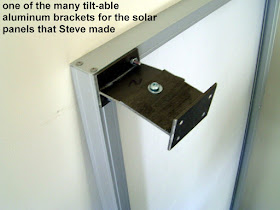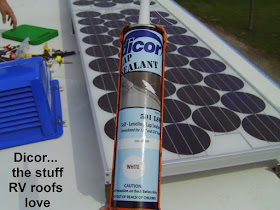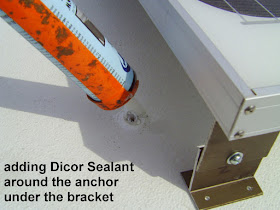*~*~*~*~*~*~*~*~*~*~*~*~*~*~*
On our Safari motorhome, we originally had two OEM solar panels… one 75 watt for the big coach batteries and a smaller one for maintaining the chassis batteries. This setup was enough to top off our four golf cart batteries, with frugal usage we could go many days with it. But we decided to “Solar Up” with more… and be more livable and downright extravagant once we are done! LOL
We removed the old panels, as it’s never good idea to mix sizes. All panels should be the same wattage. Sold the old ones off on Ebay.
THE EQUIPMENT:
We purchased four 100 watt Siemens panels, a Blue Sky MPPT solar controller, a Trimetric gauge, and all the various cords and accessories to go along with it. We already have four 6volt golf cart batteries installed.
Steve made the mounting brackets out of heavy aluminum, and made them so supplementary metal rods can be wingnutted onto them to tilt them in the winter months if needed. The panels will ride flat the rest of the year, and only add the tilting rods if we deem it necessary. He pre-fitted the brackets while the panels were still on the ground, rather than waiting till they were up on the roof.
Let’s all sing together that James Taylor favorite:
Up On A Roof…………….
And I gingerly crawled up the ladder to assist. I HATE heights….ack! First step was to hook the four panels together into pairs of two.
Now they had to be wired up together and then joined to the two 8 gauge cords
Next comes the time to flip all four of the panels over and install the brackets to the roof… ohhh drilling holes in a roof can be VERY SCARY! Once a hole is drilled, you can’t UNdrill it!
We used some rather unique fasteners. Before you get too excited seeing “plastic”, calm down. It’s only temporary nylon guides that hold the metal toggle into place … read on:

Ahhhhh now look at that ! (about four hours later)
Well, not quite. Now Steveio had to hook up the wires in the solar controller and 30 amp fuse box. Then hook the Trimetric gauge back up to the shunt and it *should* work…..
Now it’s time to get on the roof and drill down, and pull through the heavy gauge wires for the panels. Steve carries along this ladder in our rig, an Xmas present from moi.
WIRING:
We chose a location on the roof for the panels that would not have them shadowed by any objects on the rooftop, such as roof vents and air conditioners. The slightest shadow can hamper the panel's output. We plan to face the front of the rig east as much as possible when choosing parking spots, so the panels are running lengthwise along our south side (passenger side) of the rig. We already try to park this way in the hot summer to keep our fridge on the north side cooler by being in the shade.
On the passenger side of the rig is a perfect spot to run the wires down through a hole Steve will drill in the roof, through an access panel in the closet that reveals a chase for other wiring and the plumbing vent from our washer/dryer unit. Directly below this closet is the basement compartment where the solar controller will be located.
He got the solar controller mounted, wires and ground all hooked up too.

We cut out a section of wall and installed the Trimetric Monitor gauge and the 500amp shunt used to monitor the battery condition.
The gauge is mounted in our kitchen, and the shunt is mounted under the bed close to the batteries on the negative line. Special wires come back to the wall panel.
Voila! It works! This is like “Command Central” for seeing how many volts you have in your batteries, how many amps are being used, how much is being charged etc.
Weeeeeheeeeeee it all works!
And even in cloudy afternoon sky in April we are pulling 20 amps.
Ain’t that something?
*~*~*~*~*~*~*~*~*~*~*~*~*~*~*
P.S. We find our solar panels give us ample power to do most everything we wish when boondocking (other than run the microwave or vacuum cleaner) We run the tv's, my curling iron, recharge our cell phones and cameras, run the Galaxy Tablet, and any of the lights and water pump etc. as needed. We have to remember to start up our on board Onan generator once a month to exercise it, because we don't often need it now that we are solared up.
Three helpful links we found when exploring all our solar options were:
About a year afterwards:
Steve had the chance to buy one more solar panel that matched our other ones. (we already have four 100 watts Siemens panels on the roof) Here is the panel and he got right up there and ready to work!!!
Next, he had to tilt up the set of panels to access the connector box underneath. Our four panels are tiltable with brackets that can hold up at any angle to collect the sun's rays in the winter, if need be. But we have never had to do that. The newest panel that he is installing is on a fixed bracket that will lay flat. That bracket is from the old panel and needed a bit of alteration, but he made it work.
There... all done! Wasn't that easy? LOL ...
You can also see the little 10 watt solar panel that is used to maintain the two driving (chassis) batteries.
While up on the roof, Steveio also checked over all the seams and edges and vents, looking for any potential problem spots for leaks or damage over the winter.
COSTS OF OUR SOLAR INSTALLATION:
We removed the old 75 watt solar panel and controller, sold them on Ebay for $262
We already owned four 6 volt marine batteries @ $87.50 EACH $369
4 100 WATT SIEMENS SOLAR PANELS, (used total $894 )
BLUE SKY 50 MPPT SOLAR CONTROLLER, (used $268)
NEW TRIMETRIC GAUGE, SHUNT, THERMO SENSOR,
FROM ALT ENERGY SOLUTIONS (new $234 )
BREAKER BOX WITH FUSES ($24)
STEVE MADE THE BRACKETS AND USED 4 ga and 8 ga CABLES FOR CONNECTION (APPROX VALUE $200)
ONE ADDITIONAL MATCHING PANEL ADDED LATER: (used $65)
TOTAL: $1,792.00 after subtracting the sale of the old OEM panel and controller
Quiet, renewable, reliable energy
being able to boondock in comfort
.... priceless!





















































We have 240 watts and four 6v batteries. Also more than enough for our needs. Very rare do the batteries get below 12.1 resting volts. Solar works great until you get four or five rainy days in a row! Fortunately, we don't get that many rainy days here in Mexico! Love our solar panels...once you've had solar, you never go back!
ReplyDeletewww.travelwithkevinandruth.com
I think it would just be easier for me to buy your unit when you decide to get another one....then all the work has already been done and no more refitting needed. ;)
ReplyDelete(oops typo in my last comment)
ReplyDeleteHeh heh Mike... don't think we will EVER get rid of it. This is a "Million Mile Rig" as far as the diesel motor is concerned. Plus with all aluminum construction and exterior surfaces it will last a long long time. These were luxury coaches in 1996 and made to last. So many newer
rigs were made with flimsy construction, staples, glue and plastic.. or printed paper over fiberboard. You won't find none of that in our Safari.
Honestly, if anything ever happened to this one, I would probably want to replace it with exactly the same rig. With Steveio's careful maintenance, I can see us enjoying this rig for a long time to come.
But thanks for liking it!
I admire Steve's work and I'm sure a lot of planning time went in this project including the east facing parking to keep the frig cool,good thinking.
ReplyDeleteA very well explained installation process also but a few questions come to mind. Doesn't the controller require good ventilation,what length 4GA wire was used,what is the output voltage from the panels, what amperage input to batteries, what amp is the shunt, do you have a high amp fuse on the 4GA positive wire close to the batteries, and have you checked the amperage to batteries difference with the panels flat vs tilted?
I have a 10 amp difference in my 400 watt system,according to trimetric .
Mickey
Good questions Mickey!
ReplyDeleteThe solar controller is in a large open area of our basement on the motorhome. It's hard to tell from the pic, but it's open around and behind the stairwell open to the rest of the basement area. We don't have small compartments, it's all one big open storage space from front to rear axles and side to side.
The 4 ga. line is only about 5 feet long from the controller around the back tire to the shunt and battery area. (that is a different openly vented area too)
The shunt is a 500 amp from Bogart Engineering.
We have a 30amp breaker fuse box between the controller and batteries instead of just an inline fuse. That way we can pull the fuses to shut down the system if need be.
Will have to ask Steve what the output from panels contrast to input at the batteries, but the panels are rated at 5.6 amp and 17.7 volts per panel.
We have never tilted the panels yet, because even in the desert of AZ and CA last winter, we never went below 75-80% of the capacity, so never needed to. The panels recharged up each morning well before noon back to 100%.
Hope the additional information helps! thanks for asking----
Thanks for the additional information, I went back and looked at my install and I have a 80 AMP breaker at the battery on the controller input cable, where I have the 150 AMP inline fuse is between the inverter and battery. I use inverter for coffee maker and electric portable burner and will try microwave at some point, although I only have one 8D AGM 245 AH battery at this time it works fine. I still haven't figured out the total AH output from the panels on average day so not sure if more storage would be better or if too much storage would keep the batteries at a lower rate of charge.
ReplyDeleteMickey
The panels do not need to be identical, they need to be the same voltage (parallel) or current (series). For most brands, this does mean you need the same model panels together. One company (am solar) does make four different panels designed to be used together in parallel in any combination.
ReplyDeleteKaren and Steveio,
ReplyDeleteCool install! Kind of traditional meets fine craftmanship. Everyone should spend so much time on details.
As you already know, I went another way..no brackets and slightly different wiring.
If anyone else is interested take a look at:
http://wandermanblog.blogspot.com/2011/11/better-solar-charging-mouse-trap-part-1.html
Cheers!
Rich "The Wanderman"
I have the same color/year/ model coach. Trying to install 6v golf cart batteries but they are too wide for the tray.. Did you have to modify your coach batt tray? Love your blog by the way,
ReplyDeleteI don't know if this blog still works or not but here goes. Have you had to replace the freon compressor for the dash air. If yes what is the part number and where can I get one. My wife and I just purchased a 20 year old safari sahari 1996 year and I am going through a list of maintenance and repiar items prior to camping.
ReplyDeleteJoe burch
St Augustine, Fl
You bet it still does! Here is a blog post about replacing our freon first.. then a year later replacing the compressor. https://kareninthewoods-kareninthewoods.blogspot.com/2017/01/motorhome-modification-d-dash-air.html
DeleteOurs is 1996 Safari Serengeti with 3126 Cat engine. I have a LOT Of repair posts on my blog.. you can use the *search* box in right hand column to see if anything else we have already fixed helps you.
Appreciate the recommendation. Will try it out.
ReplyDelete